Nokia Solutions and Networks WTFA-01 GSM 800 Transciever User Manual dn9990375x3x0xen
Nokia Solutions and Networks GSM 800 Transciever dn9990375x3x0xen
Contents
Guide to documentation

Nokia MetroSite EDGE Base Station
DN9990375 © Nokia Corporation Draft 1 (22)
Issue 3 en Nokia Proprietary and Confidential
Guide to Documentation

Guide to Documentation
2 (22) © Nokia Corporation Draft DN9990375
Nokia Proprietary and Confidential Issue 3 en
The information in this documentation is subject to change without notice and describes only
the product defined in the introduction of this documentation. This documentation is intended
for the use of Nokia's customers only for the purposes of the agreement under which the
documentation is submitted, and no part of it may be reproduced or transmitted in any form or
means without the prior written permission of Nokia. The documentation has been prepared to
be used by professional and properly trained personnel, and the customer assumes full
responsibility when using it. Nokia welcomes customer comments as part of the process of
continuous development and improvement of the documentation.
The information or statements given in this documentation concerning the suitability, capacity,
or performance of the mentioned hardware or software products cannot be considered binding
but shall be defined in the agreement made between Nokia and the customer. However, Nokia
has made all reasonable efforts to ensure that the instructions contained in the documentation
are adequate and free of material errors and omissions. Nokia will, if necessary, explain issues
which may not be covered by the documentation.
Nokia's liability for any errors in the documentation is limited to the documentary correction of
errors. NOKIA WILL NOT BE RESPONSIBLE IN ANY EVENT FOR ERRORS IN THIS
DOCUMENTATION OR FOR ANY DAMAGES, INCIDENTAL OR CONSEQUENTIAL
(INCLUDING MONETARY LOSSES), that might arise from the use of this documentation or
the information in it.
This documentation and the product it describes are considered protected by copyright
according to the applicable laws.
NOKIA logo is a registered trademark of Nokia Corporation.
Other product names mentioned in this documentation may be trademarks of their respective
companies, and they are mentioned for identification purposes only.
Copyright © Nokia Corporation 2002. All rights reserved.
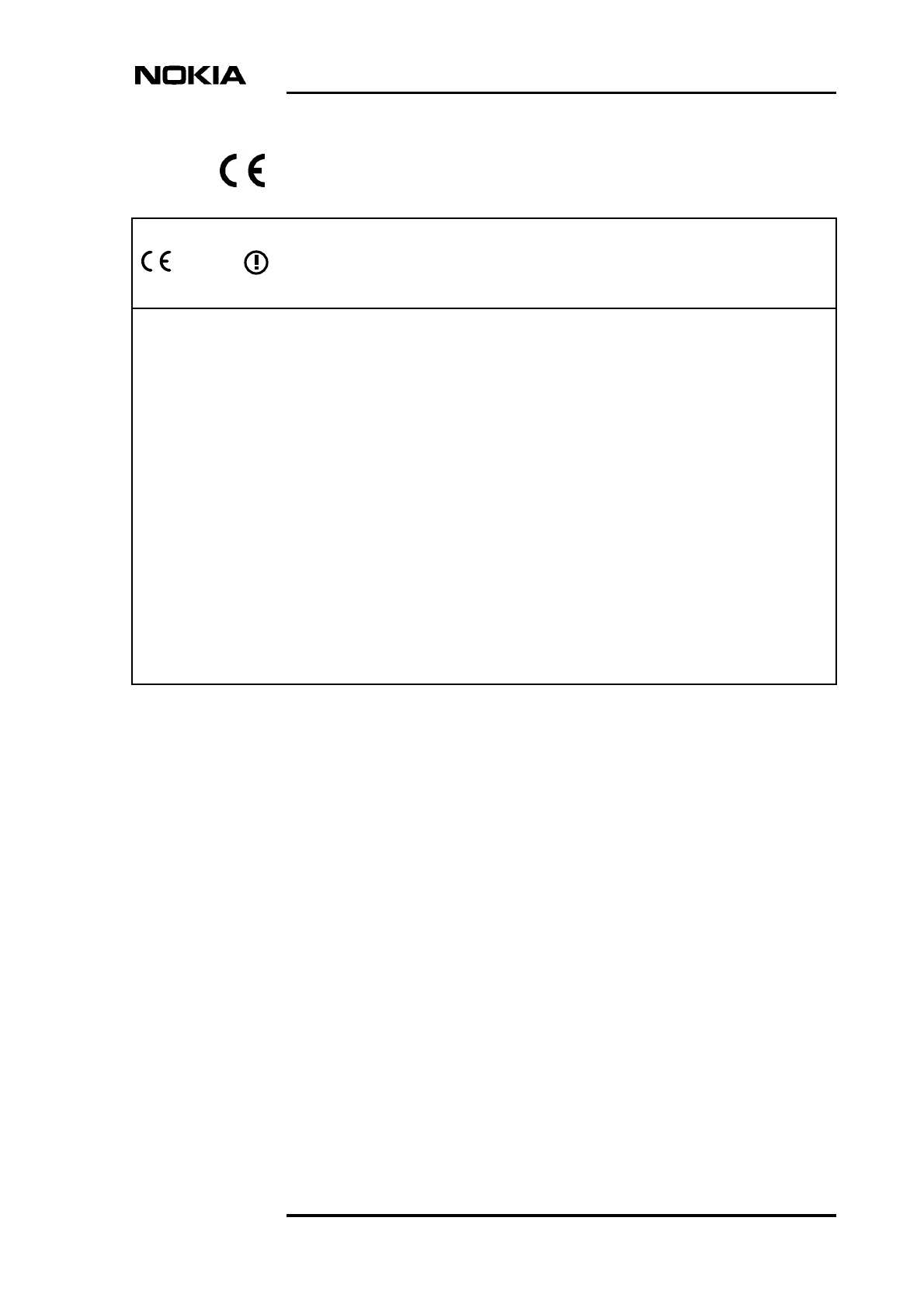
DN9990375 © Nokia Corporation Draft 3 (22)
Issue 3 en Nokia Proprietary and Confidential
Hereby, Nokia Corporation, declares that this product is in compliance with the
essential requirements and other relevant provisions of Directive: 1999/5/EC.
The product is marked with the CE marking and Notified Body number according to the
Directive 1999/5/EC
FCC FCC §15.21 - Information to user - This product is used as an intentional radiated
equipment and any changes or modifications on the equipment without any approval
by Nokia could void the user's authority to operate the equipment.
FCC §15.105 - Information to user - This equipment has been tested and found to
comply with the limits for a Class B digital device, pursuant to part 15 of the FCC
Rules. These limits are designed to provide reasonable protection against harmful
interference in a residential installation. This equipment generates, uses and can
radiate radio frequency energy and, if not installed and used in accordance with the
instructions, may cause harmful interference to radio communications. However, there
is no guarantee that interference will not occur in a particular installation. If this
equipment does cause harmful interference to radio or television reception, which can
be determined by turning the equipment off and on, the user is encouraged to try to
correct the interference by one or more of the following measures:
• Reorient or relocate the receiving antenna.
• Increase the separation between the equipment and receiver.
• Connect the equipment into an outlet on a circuit different from that to which the
receiver is connected.
• Consult the dealer or an experienced radio/TV technician for help.
0523

Guide to Documentation
4 (22) © Nokia Corporation Draft DN9990375
Nokia Proprietary and Confidential Issue 3 en

DN9990375 © Nokia Corporation Draft 5 (22)
Issue 3 en Nokia Proprietary and Confidential
Contents
Contents 5
List of tables 6
1 About this document 9
1.1 Other related documentation 9
2 Guide to Nokia MetroSite EDGE Base Station User Manual 11
2.1 Navigation aid 11
2.2 Contents by documents 12
2.3 Ordering documents 15
2.4 Delivery media 15
2.4.1 Electronic documents 15
2.4.2 Paper documents 15
2.5 Conventions used in documents 15
2.5.1 User manual identification 15
2.5.2 Document identification 16
2.5.3 Typographic conventions 16
2.6 How to give feedback 18
Appendix A. Feedback Form 19
Index 21

DN9990375 © Nokia Corporation Draft 7 (22)
Issue 3 en Nokia Proprietary and Confidential
Summary of Changes
Version 1, 12th November 1999.
Version 2, 2nd June 2000
• changed title
• added CE marking
• added references about BBU UM, Field Upgrade and System Overview
• added Accessories and Alarms Descriptions references to Chapter 2.2
• rearranged order of documents listed in Chapter 2.2
Version 3, 30th June 2001:
• updated for EDGE document set

Guide to Documentation
8 (22) © Nokia Corporation Draft DN9990375
Nokia Proprietary and Confidential Issue 3 en

About this document
DN9990375 © Nokia Corporation Draft 9 (22)
Issue 3 en Nokia Proprietary and Confidential
1About this document
This document describes the scope, structure, and use of the Nokia MetroSite
EDGE Base Station (BTS) User Manual which is also a subset of Nokia
MetroSite solution documentation.
This document describes the generic customer documents which are produced by
the Nokia MetroSite EDGE Base Station manufacturer. Customer-specific
documents are not described here.
This document is a source for the following information:
• navigation aid for finding the desired information
• general contents of each document
• ordering the User Manual
• delivery media
• conventions used in this manual
• how to give feedback
Readership
This manual is for the application planning, installation and commissioning
personnel of the Nokia MetroSite EDGE Base Station. The reader is assumed to
have a basic knowledge of base station equipment and systems.
1.1 Other related documentation
The following documentation is related to this User Manual, but not included in
it:
• Nokia MetroSite EDGE Base Station System Overview
• Nokia MetroSite EDGE GSM Base Station Product Overview
• Nokia CX 3.0 Software Release Binder

Guide to Documentation
10 (22) © Nokia Corporation Draft DN9990375
Nokia Proprietary and Confidential Issue 3 en
• Nokia MetroHub Transmission Node User Manual
• Nokia MetroHopper with FXC RRI User Manual
• Nokia FlexiHopper with FXC RRI User Manual
• Nokia MetroSite Battery Backup User Manual
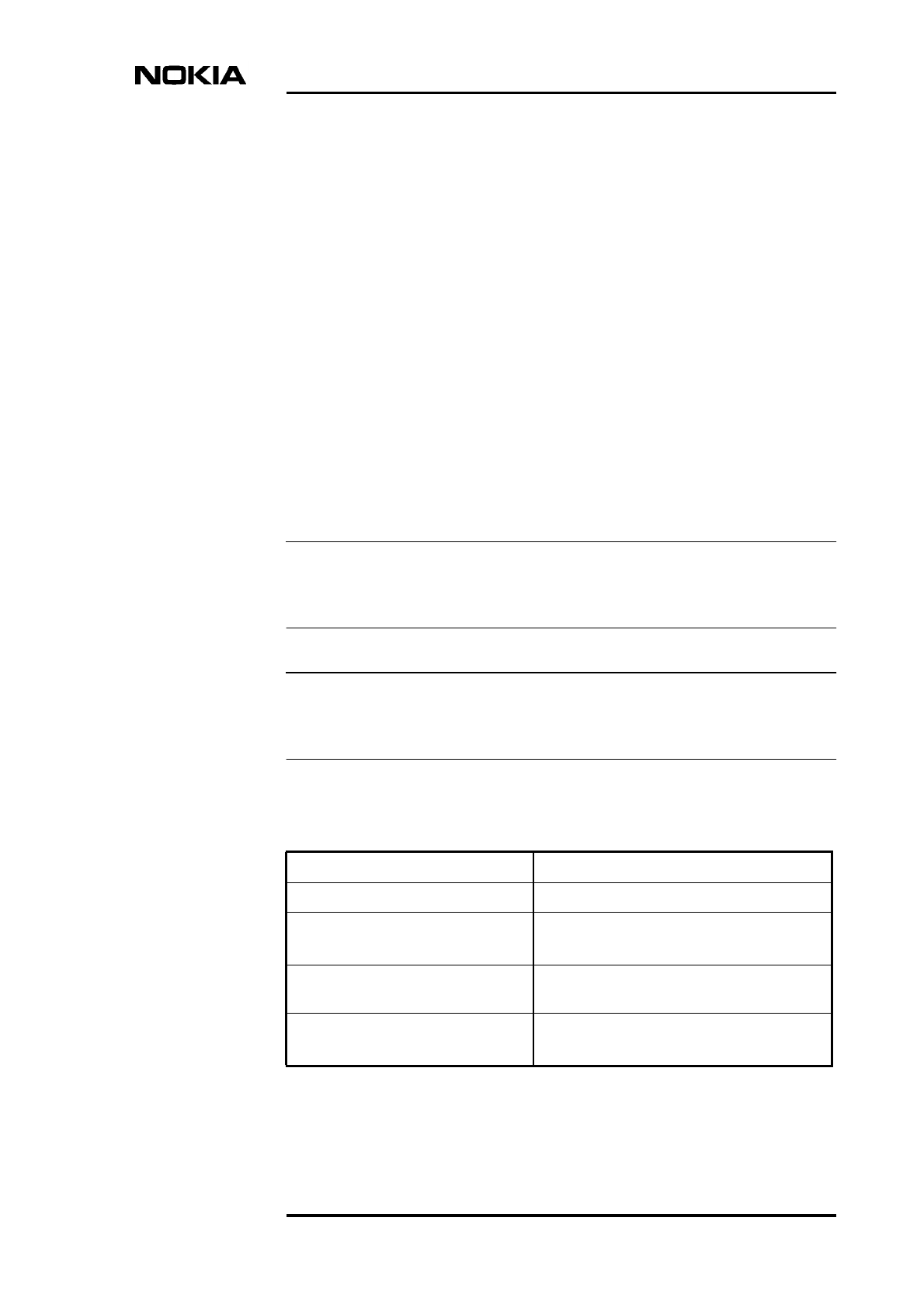
Guide to Nokia MetroSite EDGE Base Station User Manual
DN9990375 © Nokia Corporation Draft 11 (22)
Issue 3 en Nokia Proprietary and Confidential
Note
Note
2Guide to Nokia MetroSite EDGE Base
Station User Manual
2.1 Navigation aid
This section helps you find the documents that you need in order to accomplish a
certain task. The tasks are sorted in alphabetical order.
Detailed information on the contents and functionality of the BTS software and
alarm information can be found in the Software Release Binder.
Detailed instructions on how to use Nokia MetroSite BTS Manager are given in
the Nokia MetroSite BTS Manager on-line Help.
Table 1. Navigation aid for the User Manual documents
Information on Is found in
Cables and connectors Product Description (connectors on the units)
Commissioning Nokia MetroSite
EDGE Base Station
Commissioning
Nokia MetroSite BTS Manager on-line Help
Features of the Nokia MetroSite
EDGE Base Station
Product Description
Installing the Nokia MetroSite EDGE
Base Station
Requirements for Installation and Operation
Installation
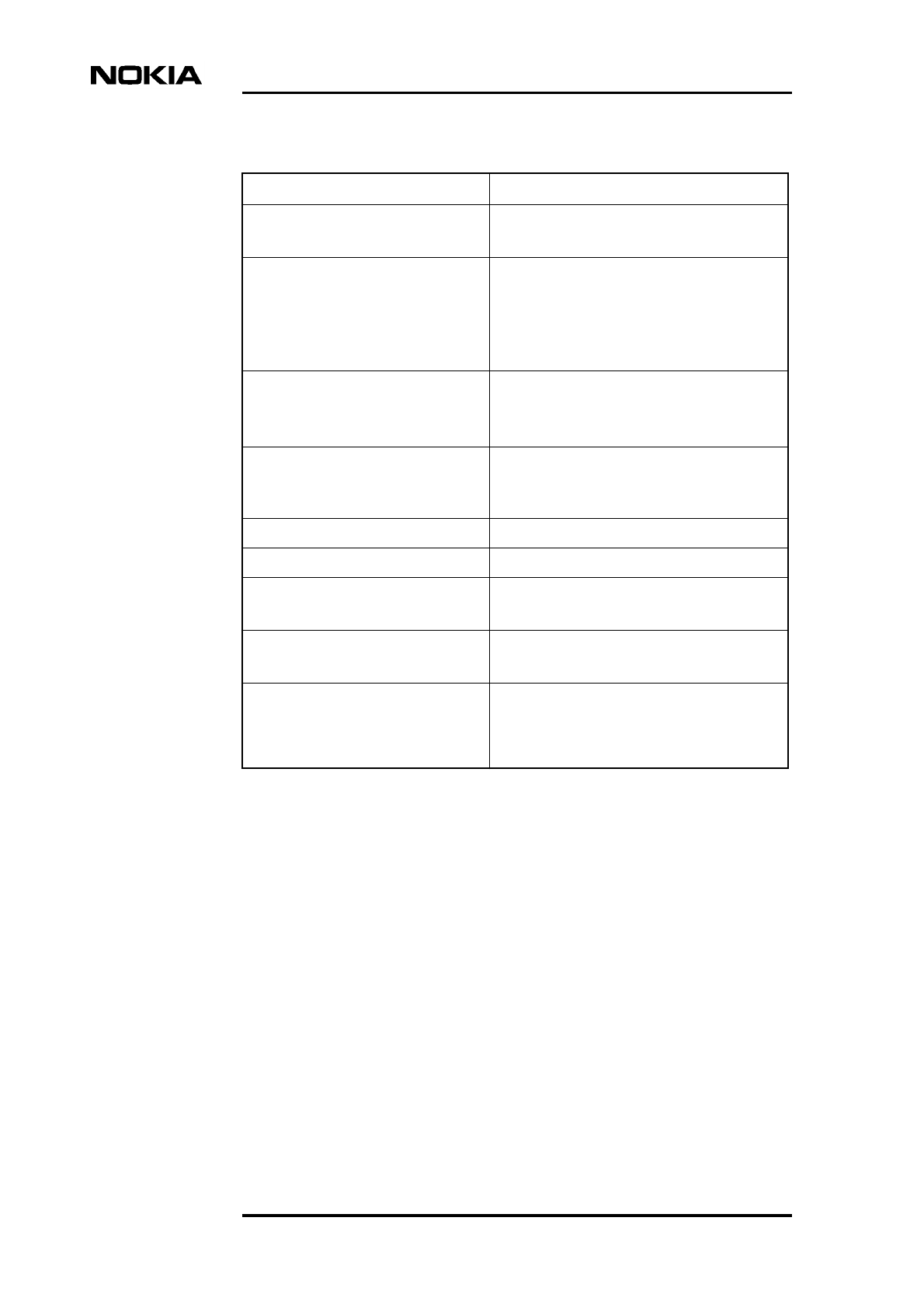
Guide to Documentation
12 (22) © Nokia Corporation Draft DN9990375
Nokia Proprietary and Confidential Issue 3 en
2.2 Contents by documents
This section describes the general contents of individual documents in this user
manual. The user manual also contains an appendix; Nokia MetroSite System -
Accessories.
Warnings and Cautions
• definition of a warning and a caution
• warnings and cautions concerning handling and using Nokia MetroSite
EDGE Base Stations
• safety distance calculations
Maintaining the Nokia MetroSite
EDGE Base Station
Maintenance
Nokia MetroSite BTS Manager on-line Help
Managing the Nokia MetroSite
EDGE Base Station locally
Product Description (brief overview on Nokia
MetroSite BTS Manager)
Commissioning (how to get started with the
Nokia MetroSite BTS Manager)
Nokia MetroSite BTS Manager on-line Help
Planning the application/installation Warnings and Cautions
Product Description
Requirements for Installation and Operation
Standards Product Description (all standards)
Requirements for Installation and Operation
(environmental standards)
Technical specifications Product Description
Terminology Glossary
Tools (used in installation and
maintenance)
Requirements for Installation and Operation
Installation
Upgrading the Nokia MetroSite
EDGE Base Station
Maintenance
Field Upgrade
How to locate information on
procedures, main tasks, features,
terms, operation, units of the BTS,
and the BTS in general.
Index
Table 1. Navigation aid for the User Manual documents (Continued)
Information on Is found in

Guide to Nokia MetroSite EDGE Base Station User Manual
DN9990375 © Nokia Corporation Draft 13 (22)
Issue 3 en Nokia Proprietary and Confidential
Glossary
• technical abbreviations and acronyms used in this manual
• other technical key terms used in this manual
Product Description
• description of features
• description of BTS applications
• description of software
• description of construction, plug-in units and their functionality
• technical specifications and standards
Requirements for Installation and Operation
• environmental specifications
• general requirements for the site
• space requirements and mounting locations
• requirements for grounding and site power supply
• site power consumption
• list of tools needed for the installation
Installation
• contents of the delivery
• unpacking instructions
• installation equipment
• wall mounting instructions
• pole mounting instructions
• cabinet cabling instructions
Field Upgrade
• upgrade types and required parts
• power precautions when working on the BTS
• unit removal procedures
• unit installation procedures

Guide to Documentation
14 (22) © Nokia Corporation Draft DN9990375
Nokia Proprietary and Confidential Issue 3 en
Commissioning
• commissioning software overview
• getting started with Nokia MetroSite BTS Manager
• manual commissioning with Commissioning Wizard
• Traffic Manager
• line interface and synchronization settings
• Radio Wizard
• cross-connections
• troubleshooting and fault reporting
Alarms Descriptions
• handling BTS alarms
• alarm examples
• list of alarm descriptions
• fault reporting
• troubleshooting for faults
Maintenance
• periodic maintenance measures
• LED indicator descriptions
• 13 MHz clock adjustment
• instructions for replacing units
• instructions for expanding the BTS’s capacity
• troubleshooting for faults
Accessories
• lists Nokia MetroSite supporting accessories
• descriptions and specifications of accessories
• assembly and installation instructions
Index
• A retrieval aid for locating information on procedures, main tasks, features,
terms, operation, units of the BTS, and the BTS in general.

Guide to Nokia MetroSite EDGE Base Station User Manual
DN9990375 © Nokia Corporation Draft 15 (22)
Issue 3 en Nokia Proprietary and Confidential
2.3 Ordering documents
You can order Nokia MetroSite EDGE Base Station documents in electronic
and/or paper format. The documents are always delivered in the NED (Nokia
Electronic Documentation) package or in User Manual binders. The NED
package of Nokia MetroSite contains, in electronic format, the user manuals for
all Nokia MetroSite products. To order the documents, contact your local Nokia
representative.
2.4 Delivery media
2.4.1 Electronic documents
The NED viewer provides electronic access to Nokia documentation.
Each NED package includes the necessary software and documentation:
• Nokia Documentation CD ROM, containing document sets and the NED
Viewer
• NED User Guide
• NED Quick Reference Card
For more information about NED, refer to the NED User Guide.
2.4.2 Paper documents
Paper documents are delivered in binders:
• Each binder contains a content list, helping you to locate the required
document.
• The binder label gives the product’s name and code.
2.5 Conventions used in documents
2.5.1 User manual identification
For identification and version management purposes, the user manual and all
documents in it are coded according to specific principles. The code and the
version of the user manual can be found on the binder label. The NED code can
be found on the back cover of the CD ROM package.
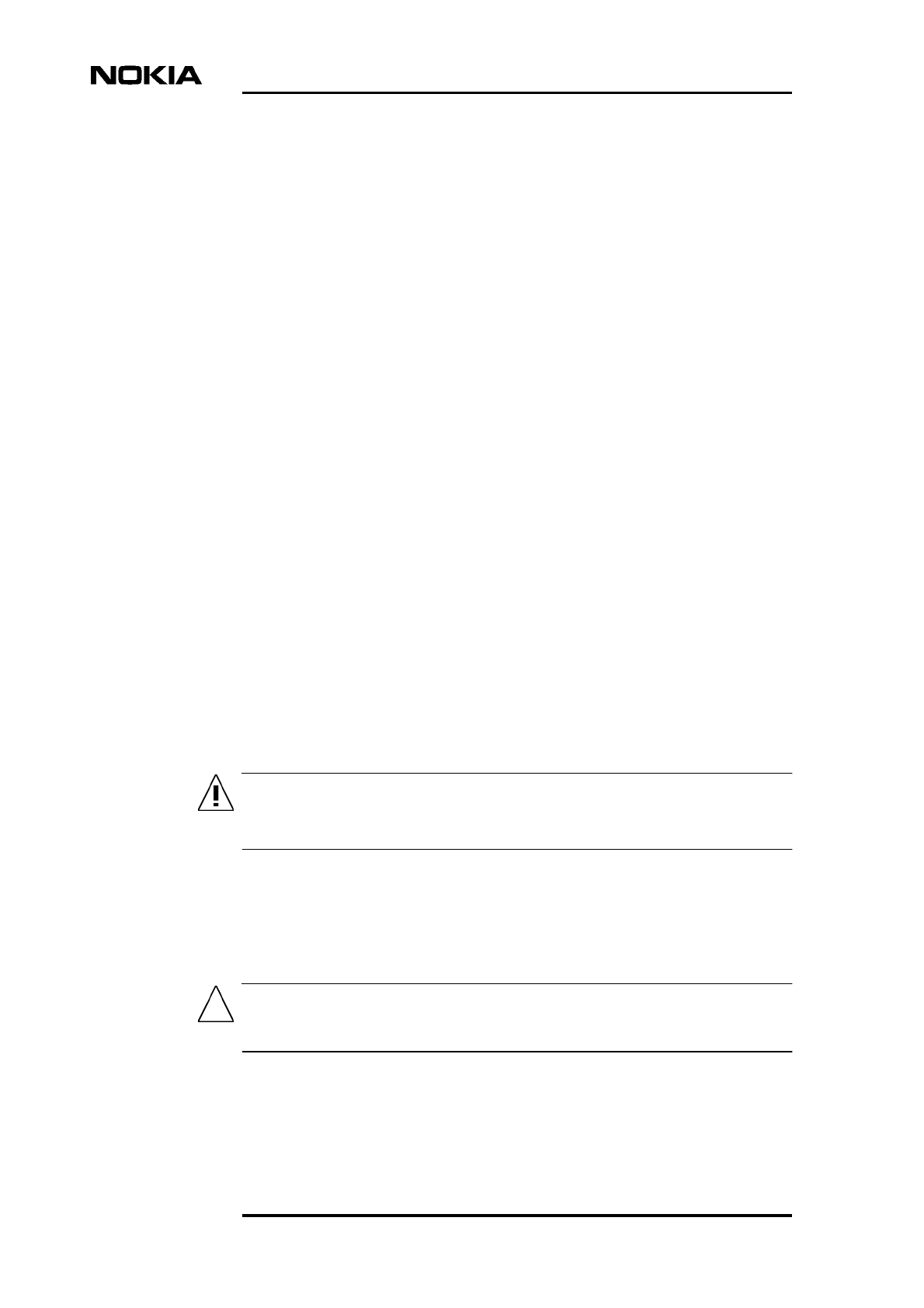
Guide to Documentation
16 (22) © Nokia Corporation Draft DN9990375
Nokia Proprietary and Confidential Issue 3 en
WARNING
Caution
2.5.2 Document identification
All documents are identified by number, version, and language. These elements
combined form a document identifier.
Example of a document identifier:
DN98123 issue 1-0 en
•DN98123 is the document number.
•1is the issue number, which increases when the contents of the document
are changed; 0is the editorial number, which increases when the document
format is corrected without changes being made to documents.
•en is the language code, taken from the ISO 639 standard.
In paper documents, the document identifier is in the lower left-hand corner of the
page. In electronic documents, the document identifier can be viewed by clicking
the icon in the upper right-hand corner at the beginning of each document. When
the document is printed, the document identifier and name appear on each page.
2.5.3 Typographic conventions
Icons and different fonts are used to emphasise special elements of the document.
The icons are located in the left-hand side of text.
Warnings
Warnings alert the reader to dangers which may cause loss of life, physical injury,
or ill health.
This is a warning!
Cautions
Cautions are used to indicate possible damage to equipment but not danger to
personnel.
This is a caution!
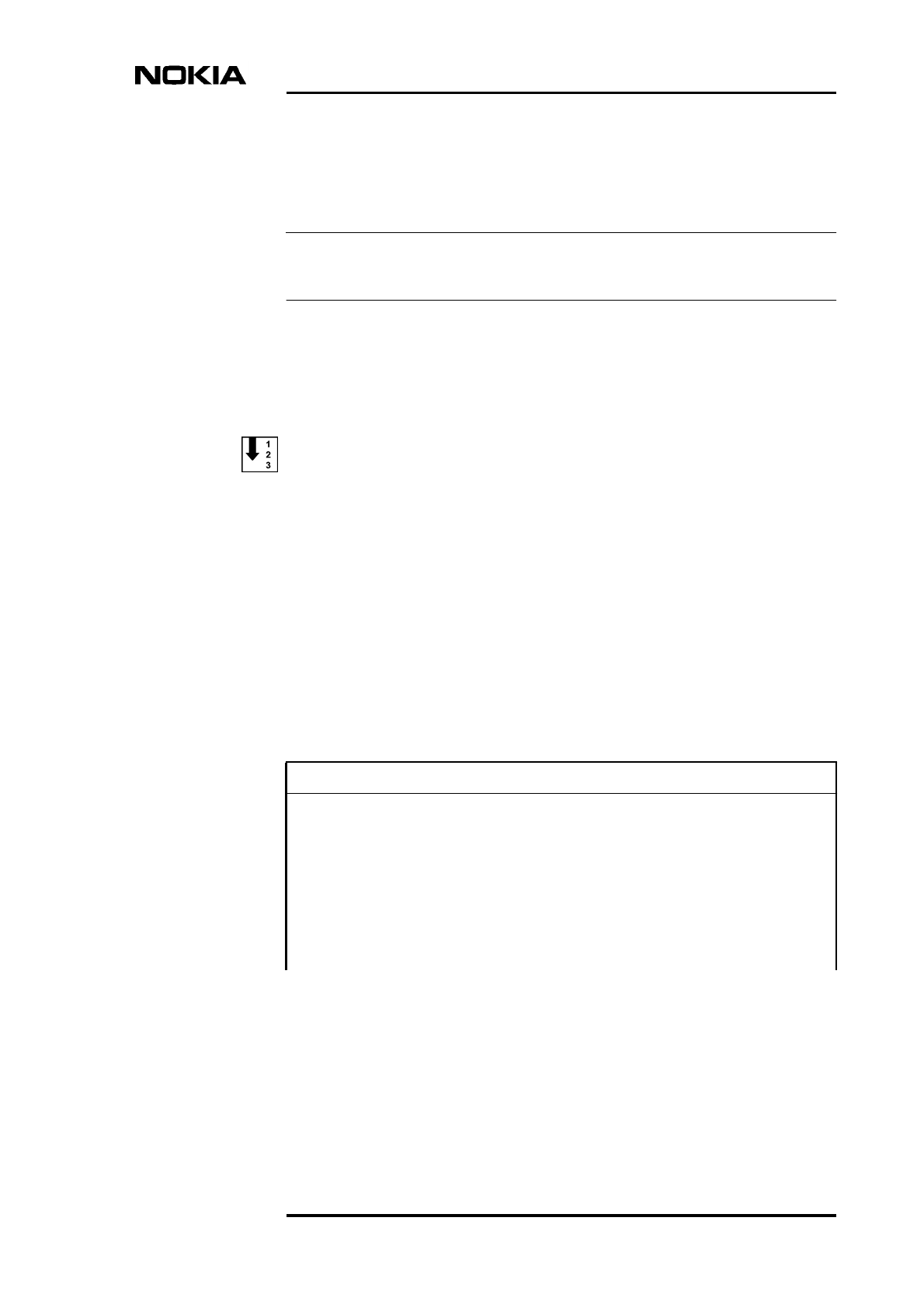
Guide to Nokia MetroSite EDGE Base Station User Manual
DN9990375 © Nokia Corporation Draft 17 (22)
Issue 3 en Nokia Proprietary and Confidential
Note
Notes
Notes are used to call attention to a certain piece of information.
This is a note.
Task sequences/procedures
The task sequence/procedure symbol is used to indicate the beginning of a task
sequence.
Task sequence/procedure:
1. Step 1.
2. Step 2.
3. Step 3.
Text conventions
Table 2 lists the text conventions used in the documentation.
Table 2. Text type conventions in the User Manual documents
Convention Description
italic font Used when mentioning the title of a manual,
chapter or section. For example: Refer to Test Call
Handling, Command Reference Manual.
Used in MML (Man Machine Language) for
names of user interface windows, such as: the
BTS Properties window.
Courier font Used in MML (Man Machine Language) coding
examples, such as: Run:Test case;

Guide to Documentation
18 (22) © Nokia Corporation Draft DN9990375
Nokia Proprietary and Confidential Issue 3 en
Index conventions
Index entries consist of the entry word, the name of the document in which
information related to the entry can be found and the page number.
The following is an example of an index entry:
cable diameters Requirements for Installation and Operation 31, 34
2.6 How to give feedback
We appreciate your feedback. Your comments are a valuable source of
information for continuous improvement of our documentation. To provide
feedback, please return the attached feedback form (Appendix A) to your local
Nokia representative.
If you find any problems with our documentation, please contact your local Nokia
representative.
CAPS Used in MML (Man Machine Language)
commands, such as: click FILE | EXIT; or click the
CANCEL button.
SMALL CAPS keyboard short-cuts, such as CTRL+F7
bold Used to emphasise text parts in electronic
documents.
Table 2. Text type conventions in the User Manual documents (Continued)
Convention Description
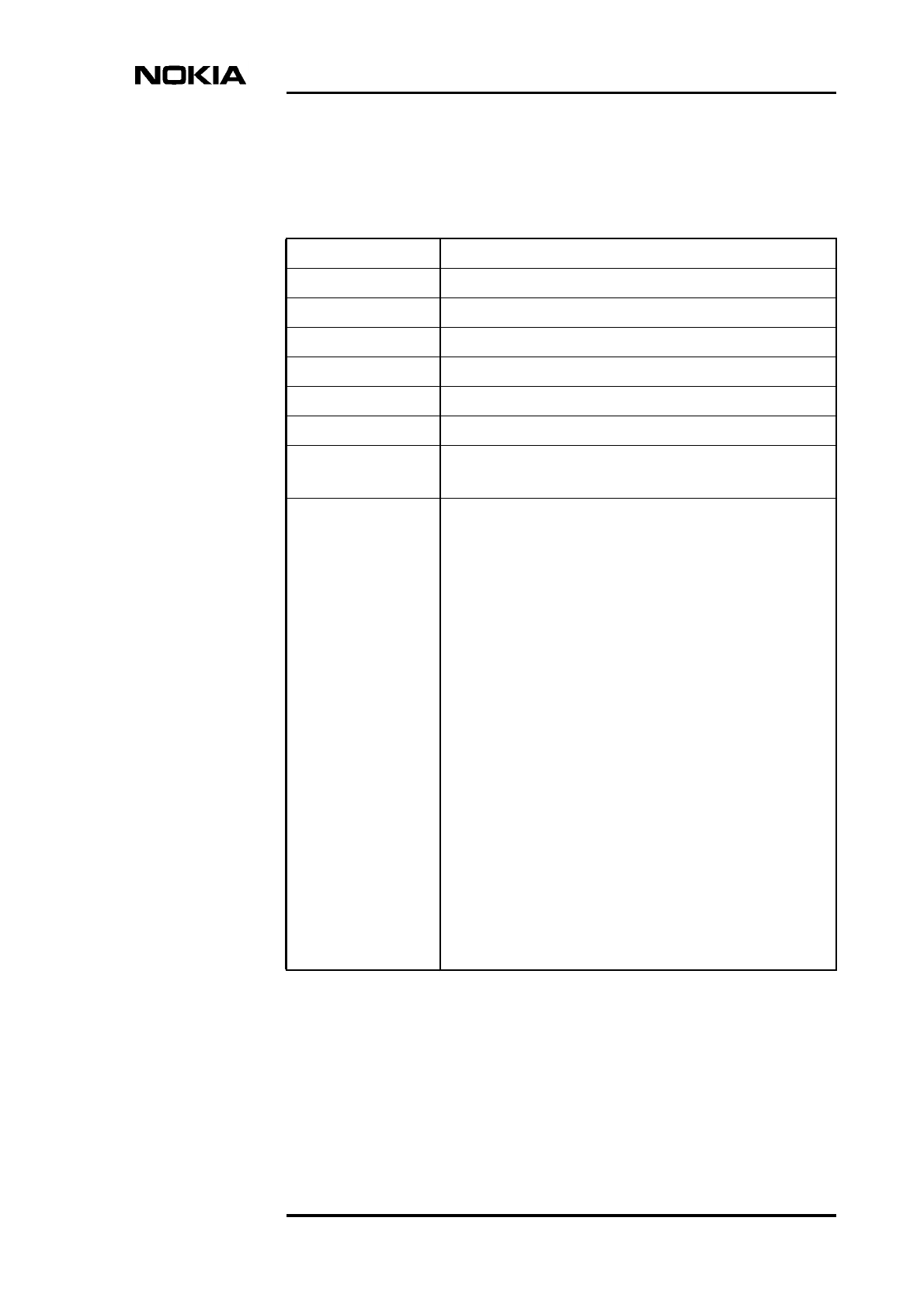
Feedback Form
DN9990375 © Nokia Corporation Draft 19 (22)
Issue 3 en Nokia Proprietary and Confidential
Appendix A. Feedback Form
Table 3. Document feedback form
Document Name:
Document identifier:
Document category:
Product Name and version:
Sender Your name:
Job Title:
Company:
Address:
Your comments

Guide to Documentation
20 (22) © Nokia Corporation Draft DN9990375
Nokia Proprietary and Confidential Issue 3 en

Guide to Documentation
22 (22) © Nokia Corporation Draft DN9990375
Nokia Proprietary and Confidential Issue 3 en

